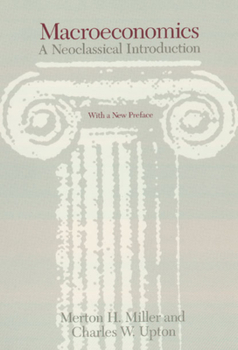Macroeconomics: A Neoclassical Introduction
Select Format
Select Condition 
Book Overview
"Miller and Upton is by far the most cited macroeconomics text in front line academic research journals over the last ten years. It has become a contemporary classic."--Roger C. Kormendi, University of Michigan "The most innovative approach to introducing macroeconomics that I have seen. . . . A 'classic' in the sense that every serious student of macroeconomics is likely to want it in his or her library."--John P. Gould, University of Chicago...
Format:Paperback
Language:English
ISBN:0226526232
ISBN13:9780226526232
Release Date:October 1986
Publisher:University of Chicago Press
Length:384 Pages
Weight:1.15 lbs.
Dimensions:0.8" x 6.1" x 9.1"
Customer Reviews
2 ratings
Exactly what I expected
Published by Thriftbooks.com User , 15 years ago
The book arrived in a timely manner and the condition was just as described. Very satisfied!
An eccentric classic
Published by Thriftbooks.com User , 23 years ago
This book is not for lay people or even undergraduates. Not that it is all that technically demanding. Rather, it is unusual in its style and content. This text is a landmark in modern macroeconomics. It begins with a very simple model for the ideas of Thomas Malthus. It was the first to place the neoclassical growth model at center stage. It is the first place to discuss in print what later became known as Ricardian Equivalence. It was written at the very dawn of the rational expectations - market clearing revolution in macro, yet betrays a deeper understanding of those ideas than most contemporary texts.It makes a radical break with IS-LM (regrettably entrenched for over 50 years) and proposes an alternative with the real interest rate (r) on one axis and the price level (P) on another. The M curve represents combinations of r and P consistent with equilibrium in the supply and demand for real balances. The Y curve represents combinations consistent of the same, consistent with market clearing for goods. The intersection of M and Y determine P and r. Real output does not appear on either axis because it is determined by the labor market. Sticky wages or prices can be (and are) incorporated into the model. I find the M-Y model much more natural than IS-LM with AD-AS.Much of the discussion is built around a computer simulation model, probably long vanished, that reminds me of a deterministic version of a simple real business cycle model. Miller and Upton understood that a lot of macroeconomics can be explored within a spreadsheet, even though spreadsheets had yet to be invented!Finally, the prose is rich and beautiful, reflecting the shining influence of the late Merton Miller, a wise and witty writer.





